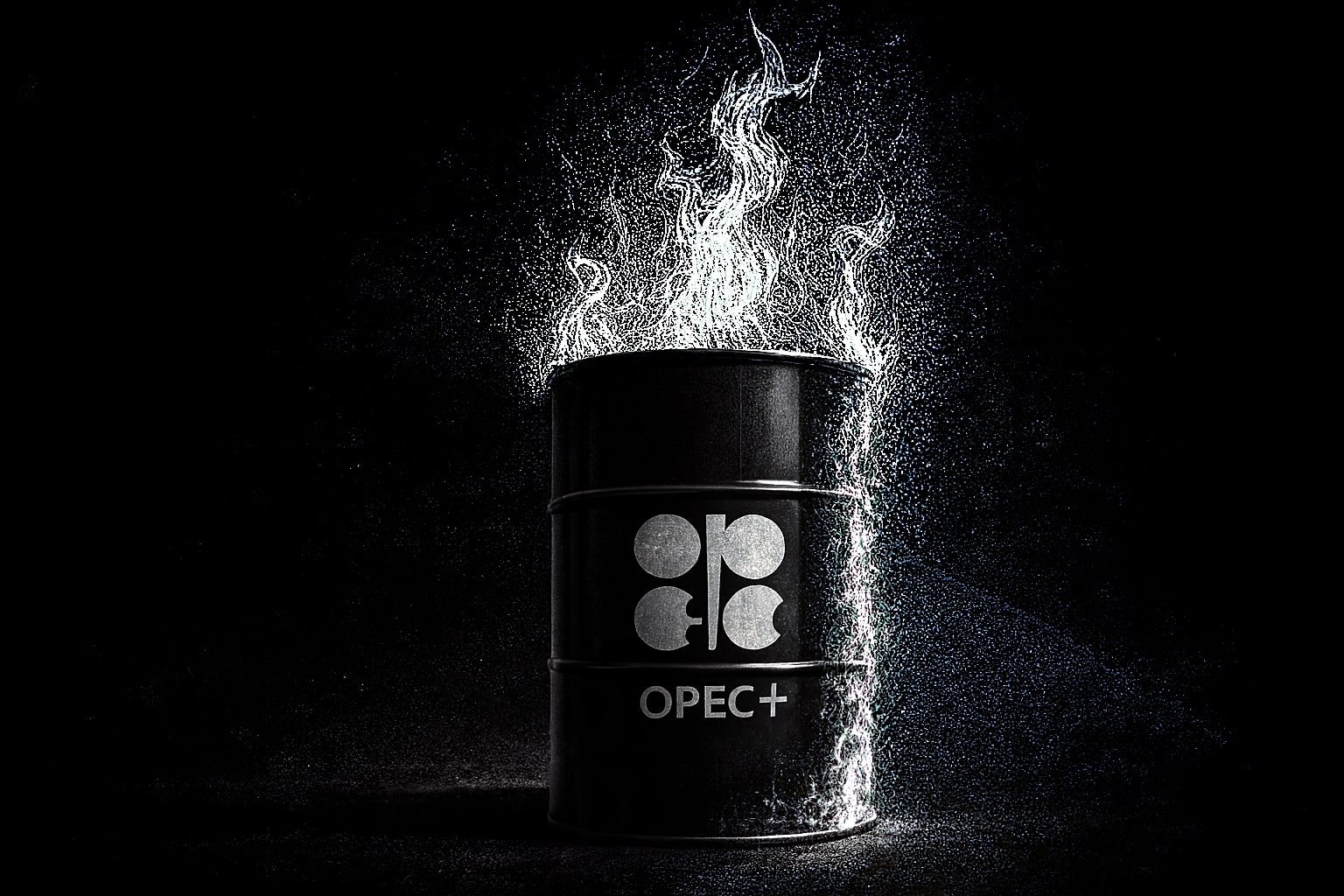
Oil Prices Face Pressure from U.S. Inventory Builds and Geopolitical Concerns: Can OPEC’s Production Plans Stabilize the Market?
As WTI Crude drops to $61 and Brent to $64, oil investors are balancing fears of oversupply with OPEC+ production adjustments. How will the summer driving season and geopolitical risks impact the market’s outlook? | That's TradingNEWS
Oil Prices Retreat Amid U.S. Inventory Surprises and Rising Geopolitical Risks
Oil prices, including Brent crude and WTI crude (CL=F), have faced downward pressure in recent days, with Brent dropping to $64.82 per barrel and WTI hitting $61.50 per barrel. These declines followed an unexpected build-up in U.S. oil inventories, as reported by the Energy Information Administration (EIA). Crude oil inventories in the U.S. saw an increase of 1.3 million barrels, while gasoline and distillate stocks also rose. This surprised many traders who were anticipating a drawdown, as the summer driving season approaches, often a period of increased demand. The fear of an oversupply situation, especially with rising U.S. inventory levels, continues to weigh on the market, despite the typical demand surge expected in the coming months.
However, the situation remains complex. While WTI Crude struggles with the oversupply concerns, there's speculation that increased demand during the summer driving season could alleviate some pressure. According to Nissan Securities analyst Hiroyuki Kikukawa, the market is closely watching the balance between inventory builds and seasonal consumption, as it might limit further price declines. The market remains volatile, and prices will likely be influenced by how quickly U.S. inventories draw down during the peak driving months. But will geopolitical risks in the Middle East create further uncertainty for oil prices?
Geopolitical Tensions and OPEC’s Upcoming Strategy Add Volatility to Oil Market
Geopolitical risks also play a significant role in oil price volatility. Recently, Brent crude saw a temporary price spike on rumors that Israel was planning airstrikes on Iranian nuclear facilities. This news, which came from U.S. intelligence sources, pushed oil prices up by 1%, demonstrating just how sensitive the oil market is to geopolitical concerns. If tensions in the Middle East continue to escalate, especially with the ongoing negotiations between the U.S. and Iran, oil prices could be driven higher in the short term. However, these risks remain uncertain, and as the situation with Iran’s nuclear program remains unresolved, investors face the potential for volatility.
In addition to geopolitical risks, OPEC+ plays a crucial role in oil price movements. As OPEC+ discusses a potential production increase for July, the market is anticipating how this decision will affect global supply and demand. The possibility of an increase of 411,000 barrels per day (bpd) for July is on the table, though a final agreement has not yet been reached. The production cuts that were implemented earlier in the year are now being revisited, as OPEC+ debates how much supply is needed to maintain price stability amid concerns over potential demand slowdowns. Saudi Arabia, in particular, has been using production cuts strategically to punish over-producers in the OPEC+ agreement, as they seek to maintain long-term stability in the oil market. This decision by OPEC+ will be pivotal, especially considering that rising yields in U.S. Treasury bonds could signal lower global demand in the near term.
Could OPEC’s Strategy and Global Production Shifts Lead to a More Balanced Oil Market?
With OPEC+ deliberating over further output hikes and the uncertainty surrounding geopolitical risks, the oil market is at a crossroads. Will OPEC+ be able to align its production increases with actual demand growth, or will the strategy risk flooding the market with supply, putting additional downward pressure on oil prices? Analysts suggest that OPEC+’s strategy to increase production by 411,000 bpd could lead to further challenges for oil prices, especially as U.S. shale production remains strong, despite the $61 per barrel price level. Additionally, Saudi Arabia’s willingness to tolerate short-term pain for long-term gain could push oil prices even lower if global demand doesn’t match the supply increases that are being discussed.
Meanwhile, OPEC+ faces challenges from U.S. shale producers, whose production continues to increase even with lower prices. The recent EIA inventory reports showed that U.S. crude imports were at a six-week high, while demand for gasoline and middle distillates has slipped. These developments could signal a shift in the oil supply chain, with U.S. exports possibly becoming more attractive to Europe and Asia if domestic stockpiles continue to rise. With increasing Treasury yields and a shift in demand dynamics, will oil prices be able to maintain their current levels, or will rising inventory levels and geopolitical risks drag prices lower?
ONGC’s Diversification Strategy Amid Oil Price Volatility
On the corporate front, ONGC (Oil and Natural Gas Corporation), India’s largest oil and gas producer, has been facing challenges due to the volatile nature of oil prices. In their recent fourth-quarter report, ONGC reported a 35% drop in profits due to higher exploration costs. The average realized price for oil during the quarter was $73.72 per barrel, down by 9% from the previous year. This decline in profits highlights the pressure that even the largest companies in the oil industry are facing due to price fluctuations. As a response, ONGC has announced significant diversification plans, investing heavily in renewable energy projects like wind and solar power, and expanding into hydropower, biogas, and green hydrogen. The company plans to invest $11.5 billion into green energy, signaling a shift in strategy away from traditional oil reliance. This diversification is seen as a hedge against the volatility of oil prices, which are expected to face continued fluctuations amid global economic uncertainties.
Can OPEC+ Navigate the Complexities of Production Increases Without Over-Saturating the Market?
As OPEC+ faces discussions around boosting production, its strategy could set the tone for the coming months. With prices currently hovering at $61 per barrel for WTI and $64 for Brent, the risk of overproduction is high. The delicate balance between meeting global demand and avoiding a price crash due to oversupply is crucial for OPEC+. The potential rise of 411,000 bpd in July could provide a short-term relief to consumers but might add long-term pressure to prices if demand fails to catch up. Saudi Arabia’s long-term strategy to stabilize the market could be tested, especially with global supply chains shifting and rising U.S. exports. Investors will be closely monitoring how OPEC+ navigates these dynamics in the coming months, with the potential for volatility affecting the entire oil sector.
Conclusion: The Future of Oil Prices Amid Geopolitical Risks and OPEC+ Decisions
The outlook for oil prices remains highly uncertain, with both geopolitical risks and OPEC+ production strategies playing significant roles. As prices fluctuate between $61 and $64 per barrel, the market will likely continue to react to shifting dynamics in supply and demand. U.S. inventory builds are increasing the supply pressure, while geopolitical risks, such as the situation in the Middle East, are keeping traders on edge. OPEC+’s decisions in the coming months will be pivotal in determining whether oil prices can stabilize or if the market will face a period of oversupply. For now, the market remains in a delicate balancing act, with both short-term volatility and long-term strategies influencing the price trajectory.
That's TradingNEWS
Read More
-
SMH ETF: NASDAQ:SMH Hovering at $350 With AI, NVDA and CHIPS Act Fueling the Next Move
16.12.2025 · TradingNEWS ArchiveStocks
-
XRP ETFs XRPI and XRPR: Can $1B Inflows Lift XRP-USD From $1.93 Back Toward $3.66?
16.12.2025 · TradingNEWS ArchiveCrypto
-
Natural Gas Price Forecast: NG=F Falls to $3.80–$3.94 as Warm Winter Kills $5.50 Spike
16.12.2025 · TradingNEWS ArchiveCommodities
-
USD/JPY Price Forecast - USDJPY=X Slides, BoJ 0.50% Hike, Fed Cut and NFP Set the Next Big Move
16.12.2025 · TradingNEWS ArchiveForex



















